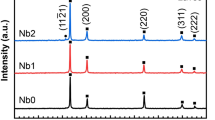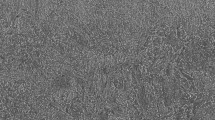Abstract
The oxidation of the 304-type (Fe18Cr10Ni) austenitic stainless steel was investigated in the temperature range 400–600 °C in 5% O2 and 5% O2 + 40% H2O. Exposure time was up to 1 week. Prior to exposure, the polished samples were coated with 0.1 mg/cm2 KCl. Uncoated samples were also exposed and used as references. The oxidized samples were analyzed by gravimetry and by ESEM/EDX, XRD, IC and AES. The results show that KCl is strongly corrosive. Corrosion is initiated by the reaction of KCl with the chromia-containing oxide that normally forms a protective layer on the alloy. This reaction produces potassium chromate particles, leaving a chromium-depleted oxide on the alloy surface. At 500 and 600 °C this results in rapid oxidation, resulting in the formation of a thick scale consisting of a mixture of hematite, spinel oxide ((Fe,Cr,Ni)3O4) and K2CrO4. The thick scale is poorly protective and permeable to e.g. chloride ions. The KCl-induced corrosion of alloy 304L in dry O2 and in an O2 + H2O mixture increases strongly with temperature in the range 400–600 °C. The strong temperature dependence is explained partly by the temperature dependence of the chromate-formation reaction and partly by the ability of the chromium-depleted oxide to protect the alloy at low temperature. At 400 °C, the oxide was still protective after 168 h.














Similar content being viewed by others
References
J. Pettersson, C. Pettersson, N. Folkeson, L.-G. Johansson, E. Skog, and J.-E. Svensson, Materials Science Forum 522–523, 563 (2006).
R. Riedl, J. Dahl, I. Obernberger, and M. Narodoslawsky, in China International Corrosion Control Conference ‘99 (China Chemical Anticorrosion Technology Association (CCATA), Beijing 1999).
J. Pettersson, H. Asteman, J.-E. Svensson, and L.-G. Johansson, Oxidation of Metals 64, 23 (2005).
H. Asteman, J. E. Svensson, L. G. Johansson, and M. Norell, Oxidation of Metals 52, 95 (1999).
H. Asteman, J. E. Svensson, M. Norell, and L. G. Johansson, Oxidation of Metals 54, 11 (2000).
H. P. Michelsen, F. Frandsen, K. Dam-Johansen, and O. H. Larsen, Fuel Processing Technology 54, 95 (1998).
H. J. Grabke, E. Reese, and M. Spiegel, Corrosion Science 37, 1023 (1995).
M. Montgomery and A. Karlsson, Materials and Corrosion 50, 579 (1999).
C. J. Wang and T. T. He, Oxidation of Metals 58, 415 (2002).
Y. Shinata, Oxidation of Metals 27, 315 (1987).
S. Y. Lee and M. J. McNallan, Corrosion 47, 868 (1991).
D. R. Lide, Handbook of Chemistry and Physics, 73rd ed, (CRC Press, 1993).
E. M. Levin, C. R. Robbins, and H. F. McMurdie, Phase diagrams for ceramists, (The American Ceramic Society Inc, 1964).
G. Anger, J. Halstenberg, K. Hochgeschwender, C. Scherhag, U. Korallus, H. Knopf, P. Schmidt, and M. Ohlinger, in Ullmann’s Encyclopedia of Industrial Chemistry (Wiley, 2007).
CRCT, École Polytechnique de Monterál Génie Chimique (Factsage, Montreal).
M. Halvarsson, J. E. Tang, H. Asteman, J.-E. Svensson, and L.-G. Johansson, Corrosion Science 48, 2014 (2006).
B, Pujilaksono, T. Jonsson, M. Halvarsson, I. Panas, J.-E. Svensson, and L.-G. Johansson, Corrosion Science (submitted).
Acknowledgements
This work was carried out within the High Temperature Corrosion Centre (HTC) at Chalmers University of Technology. The support by the member companies and the Swedish Energy board is gratefully acknowledged.
Author information
Authors and Affiliations
Corresponding author
Rights and permissions
About this article
Cite this article
Pettersson, J., Svensson, JE. & Johansson, LG. KCl-Induced Corrosion of a 304-type Austenitic Stainless Steel in O2 and in O2 + H2O Environment: The Influence of Temperature. Oxid Met 72, 159–177 (2009). https://doi.org/10.1007/s11085-009-9153-2
Received:
Revised:
Published:
Issue Date:
DOI: https://doi.org/10.1007/s11085-009-9153-2




